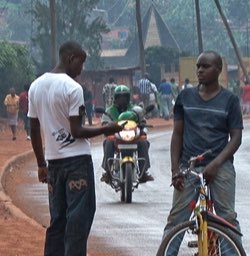Encounters with conflict and peace
It’s healthy, brave… and very difficult
“What these people have achieved in the short time since the genocide is unbelievable… this is a terrific country.” Paul Schonherr, Ambassador of the Netherlands
Let’s remind ourselves of the situation. A tiny African country, abandoned by the west, is turned on itself in genocide. At the end of three months, infrastructure is destroyed, the population is deeply traumatised. Schools, health centres, water and transport are in ruins. Families have been murdered, scattered, driven from their fields and unable to feed themselves.
The genocide ends. A trickle of returning Rwandans becomes a flood. Killers and survivors are living side by side. Everyone knows it… no-one feels safe, no-one trusts. Overcome with grief, many see no possible future - no reason to live. It sounds like a recipe for another failed African state. But within fifteen years Rwanda has brought itself back from the edge.
Kevin Terry, a British born mining engineer said, “When you think of what this country has gone through and look at where it is now, it’s something you can hardly believe.”
Leadership: a complicated challenge

But the hatred which sparked the genocide is a living memory for most Rwandans, and maintaining social stability while allowing political openness is a complicated challenge for the government. Human rights groups criticise Kagame for restricting political freedom.
Kagame is a fascinating character. However this is not really a story of leaders. It is a story of ordinary Rwandans.
< previous page | next page >
In this section
AN EXPERIMENT IN RECOVERY
Back from the edge
Experiment in recovery
A new Rwanda
JUSTICE
An overloaded system
The importance of justice
Teaching gacaca
Confronting the past
Soft justice?
Has gacaca delivered justice?
PEOPLE WHO KILLED
Helping killers
Sorry
MIND DAMAGE
Recovering from genocide
Living with the pain
Obstacles
Where does it hurt?
BUILDING PEACE
Breaking the cycle
Building peace

Back from the edge
Experiment in recovery
A new Rwanda
JUSTICE
An overloaded system
The importance of justice
Teaching gacaca
Confronting the past
Soft justice?
Has gacaca delivered justice?
PEOPLE WHO KILLED
Helping killers
Sorry
MIND DAMAGE
Recovering from genocide
Living with the pain
Obstacles
Where does it hurt?
BUILDING PEACE
Breaking the cycle
Building peace

